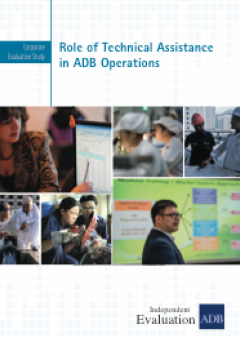
Role of Technical Assistance in ADB Operations
The rapid growth in much of developing Asia has reduced income poverty and moved many countries to middle-income status. To continue advancing, however, the region must tackle increasingly complex challenges, such as the governance of the public sector, rising inequality, and climate change.
Against this backdrop, the Asian Development Bank (ADB) technical assistance (TA), which traditionally helps to prepare projects, develop capacity of governments, undertake research, and advise on policies, must promote the use of innovative approaches more prominently and aim more systematically at providing high-quality knowledge solutions. ADB can raise the profile of TA as an instrument of change to complement financing and policy dialogue.
In principle, TA is a flexible instrument for responding to the diverse needs of the region. It is often a gap filler that complements other activities but TA is also essential for lifting the overall impact. Country case studies conducted for this evaluation highlight the breadth of TA use, from basic capacity development in the Pacific to more specialized policy advice in middle-income countries, such as financial sector reforms in Indonesia. In many cases, meaningful and successful work has been done through TA. The evaluation also validated recent completion reports and found that about 70% of TA projects were successful.
ADB can improve the relevance and responsiveness of its TA. The evaluation finds that TA has not been used to its full potential and that many of the limitations identified in an evaluation of TA performance done earlier, in 2007, remain. TA can be allocated more strategically and be better integrated into country programming, leading to stronger ownership by countries. ADB processes—e.g., project preparation and the use of consultants—need to move away from a uniform template approach and become more adaptable and responsive to both the country context and the TA objectives.
ADB's 2008 TA policy correctly identified many of these solutions as well. However, adapting ADB systems and processes and addressing issues of incentives and culture were beyond its scope. These issues now need to be picked up. Also, the growth in cofinancing of ADB's TA by partners—now half of all funding of TA—should be better aligned with ADB's longer-term priorities.
Evaluations from other international financial institutions show that there are common challenges to managing TA, which are perhaps inherent to TA being regarded as secondary to finance products. However, the recent midterm review of Strategy 2020 gives ADB an opportunity to update the 2008 TA policy and address its limitations, such as the principal reliance on consultants to implement TA, the limited use of resident missions in managing TA, and the lack of time spent on turning TA into meaningful knowledge products and services. The recommendations of this evaluation can feed into and guide relevant sections of the midterm review action plan of Strategy 2020 to provide the basis for more effective TA.
